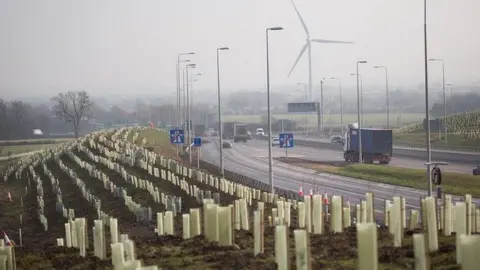'Parts of A14 still like a desert after trees die'
 National Highways
National HighwaysSections of an upgraded A road "still look like a desert" after many thousands of saplings planted as part of the £1.5bn project died.
More than 860,000 trees were planted between Cambridge and the A1, when the A14 upgrade was completed in 2020. Many died and had to be replaced by National Highways.
A Cambridgeshire County Council meeting highlighted the work the agency still has to complete, including more tree planting, restoring land and repairing a bridleway.
National Highways said: "Our ongoing environmental work remains a long-term project that we will continue to monitor and support."
"We take our responsibility to the environment very seriously. The A14 upgrade project was not limited to just improving the road," they added.
 National Highways
National HighwaysA highways and transport committee meeting on Tuesday discussed a council report on the outstanding work needed to complete the upgrade project, as reported by the Local Democracy Reporting Service.
Alex Beckett, the chair of the committee, agreed areas of the A14 "still looks like a desert out there" when the trees "should be thriving".
He said it was "incredibly frustrating" National Highways had not provided requested information.
This included detailed evidence of why the initial planting failed, where the new trees were planted, the results of surveys and an improved planting plan to ensure better success, the council said.
'Noise every day'
About 270 hectares (670 acres) of habitat, including 40 native tree and shrub species, was created for wildlife along the new section of the A14, which realigned the dual carriageway south of Huntingdon.
National Highways said in 2022 about 20-30% of the trees had died but all were replanted.
It has since said 165,000 trees and shrubs were planted between October 2023 and April 2024, 90% of which have survived.
In the meantime, people living along the road have taken matters into their own hands by planting their own trees.
Histon and Impington councillor Ros Hathorn said a "massive screen of established trees, hedgerows" had been lost and people now "live with noise every single hour of every single day".
National Highways still has to:
- Restore land used as mineral barrow pits
- Detrunk the remaining section of the old A14
- Repair a bridleway constructed as part of the project
- Open access to a "landlocked" former services at Lolworth
The agency confirmed it intends to undertake a detailed assessment of the pits; it needs to do minor works to the old A14 section before it can be detrunked; it has yet to confirm when it will carry out the bridleway works; and it has put forward a proposed access route to the former Lolworth services.
Follow Cambridgeshire news on BBC Sounds, Facebook, Instagram and X.
